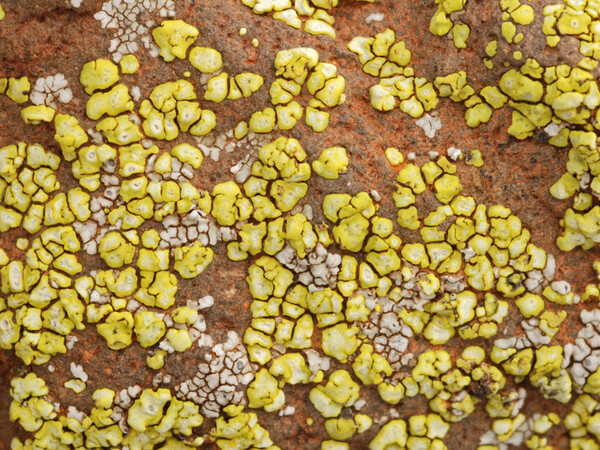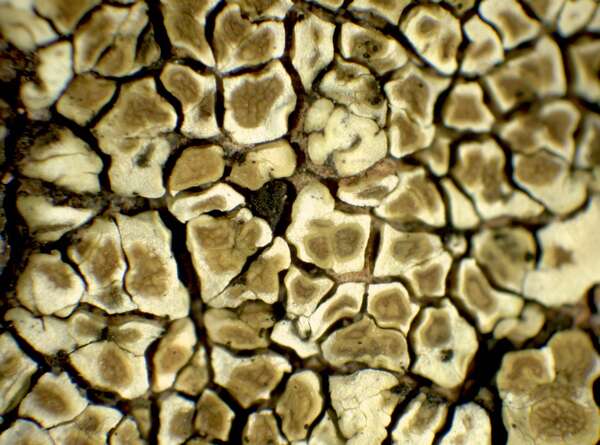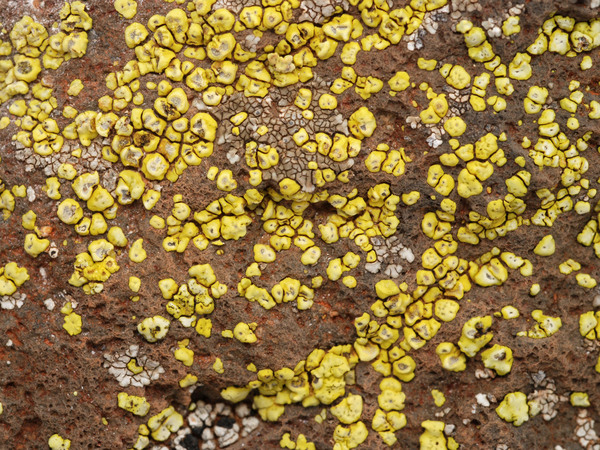Acarospora heufleriana Körb.
Parerga Lichenol.: 57, 1859.
Synonyms: Acarospora heufleriana var. massiliensis Harm.; Acarospora massiliensis (Harm.) H. Magn.; Acarospora perpulchra Hue
Distribution: N - TAA, Piem (Clerc & al. 1999), VA (Piervittori & Isocrono 1999), Lig. C - Sar. S - Camp (Garofalo & al. 1999, Aprile & al. 2002), Pugl (Garofalo & al. 1999).
Description: Thallus crustose, areolate, bright to dull yellow, forming up to 5 cm wide patches, the areoles angular, 0.5-2 mm wide, up to 0.8 mm thick, flat to convex, dispersed to usually contiguous, the peripheral ones sometimes slightly elongated, corticate. Cortex paraplectenchymatous, 30-60 µm thick, yellow in upper part, colourless in lower part; algal layer thin, continuous, the algae scattered below the apothecia; medulla white, prosoplectenchymatous. Apothecia 0.3-1 mm across, 1-5 per areole, immersed, at first punctiform then expanded, with a round to irregular, dark reddish brown disc and a thin, often inconspicuous thalline margin. Proper exciple 20-30 µm wide laterally; epithecium yellowish, 10-15 µm high; hymenium colourless, 80-135 µm high, the hymenial gel euamyloid, IKI+ persistently dark blue; paraphyses weakly coherent, 1-1.8 µm thick at base, the apical cells hardly swollen; subhymenium pale yellow, up to 40 µm high; hypothecium 20-30 µm high. Asci >100-spored, clavate, the apical dome K/I-. Ascospores 1-celled, hyaline, ellipsoid to subglobose, 3-4.5 x 2-3 µm. Pycnidia globose, immersed, the ostiole visible as a pale brown dot. Conidia bacilliform, 3-4 x 1(-1.5) µm. Photobiont chlorococcoid. Spot tests: medulla K+ yellow turning red (often forming needle-like crystals), C-, KC-, P-, UV+ orange. Chemistry: rhizocarpic and norstictic acids, the latter often in low amounts.Note: on horizontal to gently sloping faces of base-rich or weakly calciferous siliceous rocks near the ground in open habitats, especially in grasslands, sometimes starting the life-cycle on other crustose lichens, especially Lecanora valesiaca. Restricted to dry-continental areas, both in the Alps and in the Mediterranean Region. See also note on A. lavicola.
Growth form: Crustose
Substrata: rocks
Photobiont: green algae other than Trentepohlia
Reproductive strategy: mainly sexual
Subcontinental: restricted to areas with a dry-subcontinental climate (e.g. dry Alpine valleys, parts of Mediterranean Italy)
paras crustose lichens
Commonnes-rarity: (info)
Alpine belt: absent
Subalpine belt: absent
Oromediterranean belt: absent
Montane belt: very rare
Submediterranean belt: extremely rare
Padanian area: absent
Humid submediterranean belt: very rare
Humid mediterranean belt: very rare
Dry mediterranean belt: very rare

Predictive model
Growth form: Crustose
Substrata: rocks
Photobiont: green algae other than Trentepohlia
Reproductive strategy: mainly sexual
Subcontinental: restricted to areas with a dry-subcontinental climate (e.g. dry Alpine valleys, parts of Mediterranean Italy)
paras crustose lichens
Commonnes-rarity: (info)
Alpine belt: absent
Subalpine belt: absent
Oromediterranean belt: absent
Montane belt: very rare
Submediterranean belt: extremely rare
Padanian area: absent
Humid submediterranean belt: very rare
Humid mediterranean belt: very rare
Dry mediterranean belt: very rare

Predictive model
 Index Fungorum
Index Fungorum
 GBIF
GBIF





